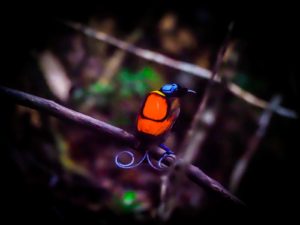Raja Ampat and its contribution to the Theory of Natural Selection
Raja Ampat is situated off the northwest tip of West Papua Province, or in the tip of the Birds Head Peninsula. Raja Ampat, meaning Four Kings is an archipelago compromising over 1500 small islands surrounding the four main isalnds of Misool, Salawati, Batanta and Waigeo. We are on Gam island which is to the west of Waigeo. We find many species that are endemic to our area, making it unique and special and this has been outlined in Alfred Russel Wallace’s extensive field work into natural selection and the establishment of the Wallace line.
These birds are rare and exotic creatures that Alfred Russel Wallace called, “one of the most beautiful and wonderful of living things”, in his book The Malay Archipelago, 1869. From 1854, the young naturalist had spent eight years travelling these islands, enduring unimaginable hardships — malaria, shipwreck, starvation and head hunters. His journeys took him on the following path, 4 July – 7 august 1860 he visited Waigeo, 7 August -25 September 1860 he visited Bessir, Gam island , 25 – 30 September 1860 he visited Waigiou, 1-2 October 1860 ,he revisited Bessir, Gam Island, 2 October – 5 November 1860 he visited Bessir, Ternate and 3-4 October Gaige Island. All of these sites were in the diameter of where Biodiversity Nature Resort is situated. While in the area he stayed in a hut that the local Papuan people had built for him. He tells of his account of the Indonesian people during the nineteenth century where he speaks fondly of them as “honest” villagers of Bessir (now Yenbeser, just 5 minutes by boat from the Resort) who housed him in a stilted hut next to white sand, “a dwarfs house, just eight feet square”! This is what he used as a base for his sample collections.
His theory on Natural Selection is supported by his observations on the Birds of Paradise, because Raja Ampat is so isolated from the western world that it has allowed for species to grow and evolve undisturbed. The islands have no known predators for the birds so they were able to adapt specifically to this region and evolve into what they are today. The male birds do not care for the young; their sole purpose is to attract as many females as possible to breed. The females raise the young on their own, meaning they need to leave the nest, unprotected, to find food. The male’s extraordinary feathers are used for the purpose of attracting a female and her selection is specific to ensure only the strongest gene is passed on for the survival of the species. Through generations they have been able to adapt to their specific environment in the best way possible, without any human or other animal threat to stop them and so supporting the theory of Natural Selection.
The birds-of-paradise are members of the family Paradisaeidae of the order Passeriformes, the whole family has 42 species in 15 genera. The only species that are so different in appearance yet all come from the same species the Paradisaeidae as well as the same region. They are found in New Guinea and few other islands of Indonesia. This makes them all the more extraordinary. We have a few of these birds in our area of Raja Ampat, the Red bird of Paradise, the Wilson bird of Paradise and the Manucodes (there are 4 species of Manucodes). We would be foolish not to take advantage of seeing these spectacular birds in their natural habitat and at the same time work towards the conservation of them. Raja Ampat Birding has to be the cream of the crop!




























